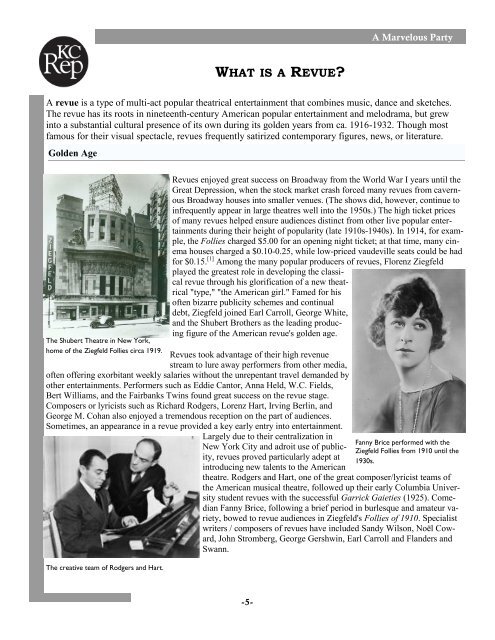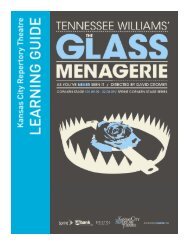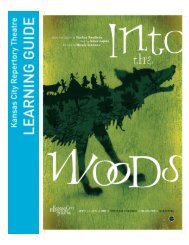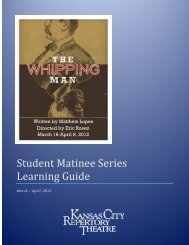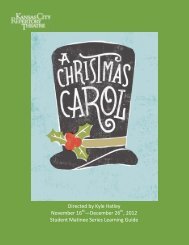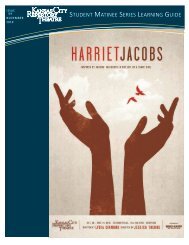A Marvelous Party - The Kansas City Repertory Theatre
A Marvelous Party - The Kansas City Repertory Theatre
A Marvelous Party - The Kansas City Repertory Theatre
Create successful ePaper yourself
Turn your PDF publications into a flip-book with our unique Google optimized e-Paper software.
-5-<br />
A <strong>Marvelous</strong> <strong>Party</strong><br />
A revue is a type of multi-act popular theatrical entertainment that combines music, dance and sketches.<br />
<strong>The</strong> revue has its roots in nineteenth-century American popular entertainment and melodrama, but grew<br />
into a substantial cultural presence of its own during its golden years from ca. 1916-1932. Though most<br />
famous for their visual spectacle, revues frequently satirized contemporary figures, news, or literature.<br />
Golden Age<br />
<strong>The</strong> Shubert <strong>The</strong>atre in New York,<br />
home of the Ziegfeld Follies circa 1919.<br />
WHAT IS A REVUE?<br />
Revues enjoyed great success on Broadway from the World War I years until the<br />
Great Depression, when the stock market crash forced many revues from cavernous<br />
Broadway houses into smaller venues. (<strong>The</strong> shows did, however, continue to<br />
infrequently appear in large theatres well into the 1950s.) <strong>The</strong> high ticket prices<br />
of many revues helped ensure audiences distinct from other live popular entertainments<br />
during their height of popularity (late 1910s-1940s). In 1914, for example,<br />
the Follies charged $5.00 for an opening night ticket; at that time, many cinema<br />
houses charged a $0.10-0.25, while low-priced vaudeville seats could be had<br />
for $0.15. [1] Among the many popular producers of revues, Florenz Ziegfeld<br />
played the greatest role in developing the classical<br />
revue through his glorification of a new theatrical<br />
"type," "the American girl." Famed for his<br />
often bizarre publicity schemes and continual<br />
debt, Ziegfeld joined Earl Carroll, George White,<br />
and the Shubert Brothers as the leading producing<br />
figure of the American revue's golden age.<br />
Revues took advantage of their high revenue<br />
stream to lure away performers from other media,<br />
often offering exorbitant weekly salaries without the unrepentant travel demanded by<br />
other entertainments. Performers such as Eddie Cantor, Anna Held, W.C. Fields,<br />
Bert Williams, and the Fairbanks Twins found great success on the revue stage.<br />
Composers or lyricists such as Richard Rodgers, Lorenz Hart, Irving Berlin, and<br />
George M. Cohan also enjoyed a tremendous reception on the part of audiences.<br />
Sometimes, an appearance in a revue provided a key early entry into entertainment.<br />
Largely due to their centralization in<br />
New York <strong>City</strong> and adroit use of publicity,<br />
revues proved particularly adept at<br />
introducing new talents to the American<br />
<strong>The</strong> creative team of Rodgers and Hart.<br />
Fanny Brice performed with the<br />
Ziegfeld Follies from 1910 until the<br />
1930s.<br />
theatre. Rodgers and Hart, one of the great composer/lyricist teams of<br />
the American musical theatre, followed up their early Columbia University<br />
student revues with the successful Garrick Gaieties (1925). Comedian<br />
Fanny Brice, following a brief period in burlesque and amateur variety,<br />
bowed to revue audiences in Ziegfeld's Follies of 1910. Specialist<br />
writers / composers of revues have included Sandy Wilson, Noël Coward,<br />
John Stromberg, George Gershwin, Earl Carroll and Flanders and<br />
Swann.


